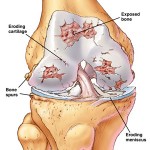Osteoarthritis and Mobility
Tuesday, November 4, 2008 Yesterday, I came across a recent article on osteoarthirits by Simon Juang from the University of British Columbia, published in the latest issue of Parkhurst Exchange.
Yesterday, I came across a recent article on osteoarthirits by Simon Juang from the University of British Columbia, published in the latest issue of Parkhurst Exchange.
Given that osteoarthritis (OA) is probably the most common cause of pain and disability in patients with obesity, as a non-expert, I found the article most informative and relevant.
The following are some of the key pieces of information I gleaned from this overview:
First of all, I was surprised to learn that OA is not always painful, but on the other hand, that not all joint pain, simply because there may be radiological signs of OA, is actually due to OA. In fact, quite often the pain may result from the structures around the joint, i.e. the muslces, ligaments, tendons, bursae, osteophytes, injury, etc. As the course of treatment may well be different, proper diagnosis of the actual source of pain is essential.
The 4 pillars of OA management include:
– patient education
– non-pharmacological interventions
– drug therapy
– appropriate referral
The 4 goals of treatment are:
– reducing pain
– maintaining range and strength
– preserving function
– dercreasing the rate of progression
As expected, the basic joint health program starts with “optimal weight”, whereby however, Huang automatically assumes that this can be fixed by “proper diet”, best achieved by referral to a dietitian (readers of these pages will likely appreciate that if obesity management was indeed that simple, we would probably not have a crisis).
Other aspects of the joint program involve physiotherapists (exercises, heating pads, nerve stimulation, etc.), occupational therapists (activities of daily living), but also orthoticists, or podiatrists.
The article also lists a number of useful resources for patients, which I list here:
– The Athritis Society
– Arthritis Resource Guide for BC
– OASIS (OsteoArthritis Service Integrated System, Vancouver Coastal Health)
– Joint Health, Arthritis Consumer Experts
– Alberta Bone and Joint Institute
– Canadian Orthopedic Foundation
Remember, while managing pain and increasing mobility will not automatically result in weight loss, impaired mobility is certainly a major barrier to any weight management program.
AMS
Edmonton, Alberta


